On the Footsteps of Active Faults from the Saronic Gulf to the Eastern Corinth Gulf: Application of Tomographic Inversion Using Recent Seismic Activity
Abstract
:1. Introduction

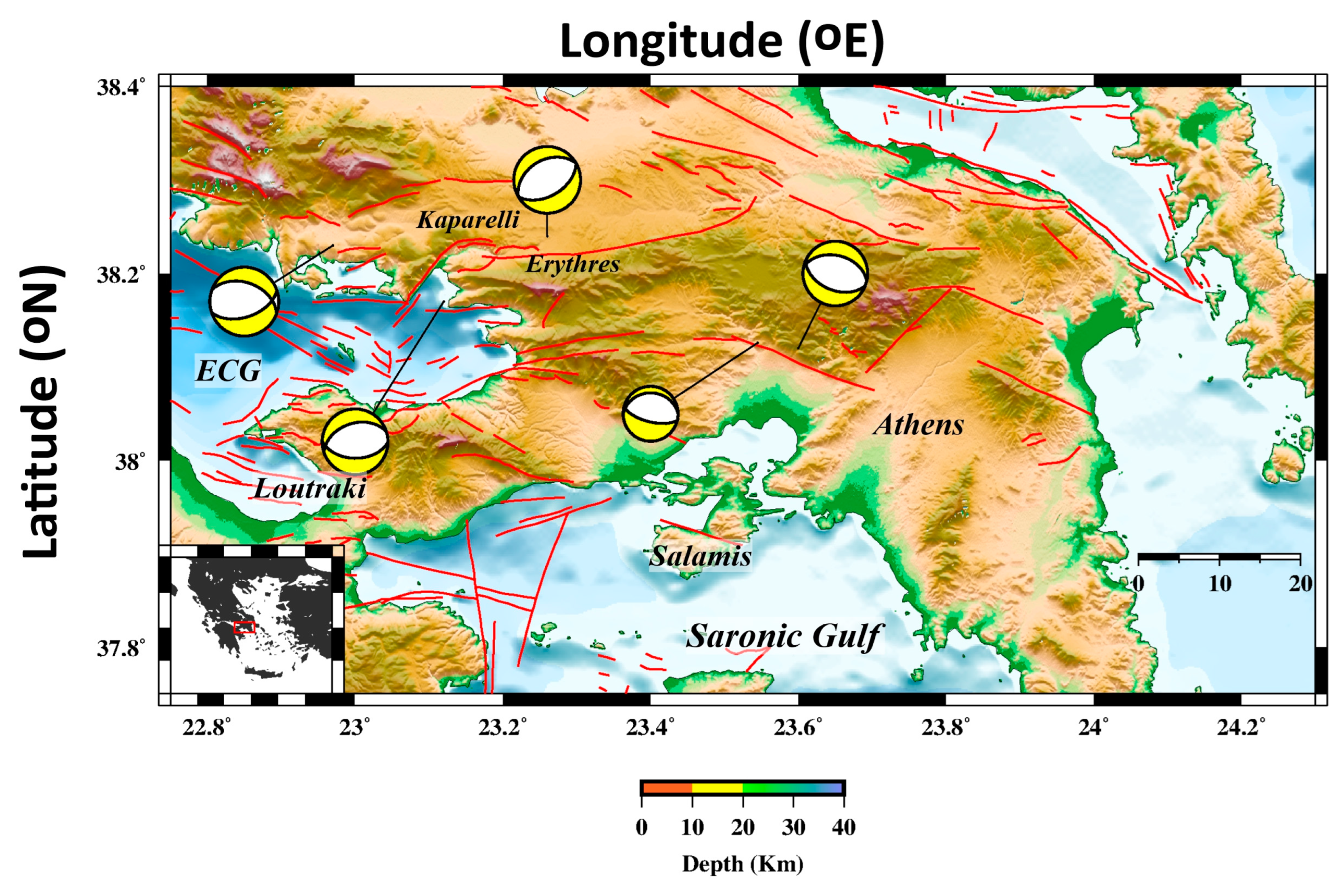
- −
- The Perachora peninsula (Eastern Corinth Gulf), where an intense earthquake sequence was initiated during the 2020–2021 time interval, presenting the characteristics of swarm activity [27].
- −
- The southern shores of Attica, in an area of approximately WNW–ESE direction, between Piraeus and Glyfada.
- −
- The area along the Leuces islands, north of Aegina.
- −
- The northern suburbs, near the Olympic facilities, near the ML = 3.2 event that occurred on 16 January 2015.
- −
- The region between Mt Penteli and Marathon Bay [28].
- −
- The Thriassion plain and its extension in the Athens basin.
- −
- A notable spatiotemporal earthquake cluster was located along the southern shores of Attica. The most notable events in this region occurred on 7 and 13 October 2023, with ML = 3.9 and 3.8, respectively, in the area east of Keratea (SE Attica).
2. Dataset and Methodology
- The nearest station epicentral distance should be less than 50 km.
- The number of the P- and S-arrival picks per event should be equal to or larger than 10.
- Temporal residual should not be larger than 0.4 s.
3. Results
4. Discussion and Conclusions
Supplementary Materials
Author Contributions
Funding
Institutional Review Board Statement
Informed Consent Statement
Data Availability Statement
Acknowledgments
Conflicts of Interest
References
- Papazachos, B.C.; Papazachou, C. The Earthquakes of Greece; Ziti Publ.: Thessaloniki, Greece, 2003; p. 286. (In Greek) [Google Scholar]
- Aksu, A.E.; Calon, T.J.; Hiscott, R.N.; Yasar, D. Anatomy of the North Anatolian fault zone in the Marmara Sea, western Turkey: Extensional basins above a continental transform. GSA Today 2000, 6, 3–7. [Google Scholar]
- McKenzie, D. Active tectonics of the Alpine-Himalayan belt: The Aegean Sea and surrounding regions Geophys. J. R. Astr. Soc. 1978, 55, 217–254. [Google Scholar] [CrossRef]
- Pichon, L.X.; Chamot-Rooke, N.; Lallemant, S. Geodetic determination of kinematics of central Greece with respect to Europe: Implications for eastern Mediterranean tectonics. J. Geophys. Res. 1995, 100, 12675–12690. [Google Scholar]
- Armijo, R.; Lyon-Caen, H.; Papanastassiou, D. East-west extension and Holocene normal-fault scarps in the Hellenic arc. Geology 1992, 20, 491–494. [Google Scholar] [CrossRef]
- Ganas, A.; Parsons, T. Three-dimensional model of Hellenic Arc deformation and origin of the Cretan uplift. J. Geophys. Res. 2009, 114, B06404. [Google Scholar] [CrossRef]
- Katsikatsos, G. La structure tectonique de l’ Attique et de l’ ile de Eubée. Bull. Geol. Soc. Fr. 1976, 19, 75–80. [Google Scholar]
- Ganas, A.; Tsironi, V.; Efstathiou, E.; Konstantakopoulou, E.; Andritsou, N.; Georgakopoulos, V.; Tsimi, C.; Fokaefs, A.; Madonis, N. The National Observatory of Athens active faults of Greece database (NOAFAULTs), Version 2023. In Past Earthquakes and Advances in Seismology for Informed Risk Decision-Making, Book of Abstracts, Proceedings of the 8th International Colloquium on Historical Earthquakes, Palaeo—Macroseismology and Seismotectonics, Kefalonia, Greece, 17–20 September 2023; Special Publication; Bulletin of the Geological Society of Greece: Athens, Greece, 2023; pp. 36–38. ISBN 978-618-86841-1-9. [Google Scholar]
- Caputo, R.; Chatzipetros, A.; Pavlides, S.; Sboras, S. The Greek Database of Seismogenic Sources (Gredass): State-of-the-Art for Northern Greece. Ann. Geophys. 2012, 55, 859. [Google Scholar]
- Kapetanidis, V.; Kassaras, I. Contemporary crustal stress of the Greek region deduced from earthquake focal mechanisms. J. Geodyn. 2019, 123, 55–82. [Google Scholar] [CrossRef]
- Ambraseys, N.N.; Jackson, J.A. Seismicity and associated strain of central Greece between 1890 and 1988. Geophys. J. Int. 1990, 101, 663–708. [Google Scholar] [CrossRef]
- King, G.C.P.; Ouyang, Z.X.; Papadimitriou, P.; Deschamps, A.; Gagnepain, J.; Houseman, G.; Jackson, J.A.; Soufleris, C.; Virieux, J. The Evolution of the Gulf of Corinth (Greece): An Aftershock Study of the 1981 Earthquakes. Geophys. J. Int. 1985, 80, 677–693. [Google Scholar] [CrossRef]
- Papadimitriou, P.; Kassaras, I.; Rigo, A.; Lyon-Caen, H.; Hatzfeld, D.; Makropoulos, K.; Drakopoulos, J. Source parameters of large and small earthquakes in Corinth Gulf (C. Greece). In Proceedings of the XXIV General Assembly of ESC, Athens, Greece, 19–24 September 1994; Volume II, pp. 848–858. [Google Scholar]
- Papadopoulos, G.A.; Drakatos, G.; Papanastassiou, D.; Kalogeras, I.; Stavrakakis, G. Preliminary Results about the Catastrophic Earthquake of 7 September 1999 in Athens, Greece. Seismol. Res. Lett. 2000, 71, 318–329. [Google Scholar] [CrossRef]
- Papadopoulos, G.A.; Ganas, A.; Pavlides, S. The problem of seismic potential assessment: Case study of the unexpected earthquake of 7 September 1999 in Athens, Greece. Earth Planets Space 2002, 54, 9–18. [Google Scholar] [CrossRef]
- Voulgaris, N.; Pirli, M.; Papadimitriou, P.; Kassaras, J.; Makropoulos, K. Seismotectonic characteristics of the area of Western Attica derived from the study of the 7 September 1999 Athens earthquake aftershock sequence. Bull. Geol. Soc. Greece 2001, 34, 1645–1651. [Google Scholar] [CrossRef]
- Ganas, A.; Papadopoulos, G.; Pavlides, S. The 7th September 1999 Athens 5.9Ms earthquake: Remote sensing and digital elevation model inputs towards identifying the seismic fault. Int. J. Remote Sens. 2001, 22, 191–196. [Google Scholar] [CrossRef]
- Louvari, E.; Kiratzi, A. Source parameters of the September 7, 1999 Athens (Greece) earthquake based on teleseismic data. J. Balk. Geophys. Soc. 2001, 4, 51–60. [Google Scholar]
- Papadimitriou, P.; Voulgaris, N.; Kassaras, I.; Kaviris, G.; Delibasis, N.; Makropoulos, K. The Mw = 6.0, 7 September 1999 Athens Earthquake. Nat. Hazards 2002, 27, 15–33. [Google Scholar] [CrossRef]
- Pyrli, M. A Contribution to Earthquake Location in Greece with the Use of Seismic Arrays. Ph.D. Thesis, University of Athens, Athens, Greece, 2005. (In Greek). [Google Scholar]
- Kaviris, G.; Kapetanidis, V.; Kravvariti, P.; Karakonstantis, A.; Bozionelos, G.; Papadimitriou, P.; Voulgaris, N.; Makropoulos, K. Anisotropy Study in Villia, 2nd ed.; ECEES: Istanbul, Turkey, 2014. [Google Scholar]
- Kaviris, G.; Zymvragakis, A.; Bonatis, P.; Kapetanidis, V.; Voulgaris, N. Probabilistic and Scenario-Based Seismic Hazard Assessment on the Western Gulf of Corinth (Central Greece). Appl. Sci. 2022, 12, 11152. [Google Scholar] [CrossRef]
- Konstantinou, K.; Mouslopoulou, V.; Saltogianni, V. Seismicity and Active Faulting around the Metropolitan Area of Athens, Greece. Bull. Seismol. Soc. Am. 2020, 110, 1924–1941. [Google Scholar] [CrossRef]
- Kapetanidis, V.; Karakonstantis, A.; Papadimitriou, P.; Pavlou, K.; Spingos, I.; Kaviris, G.; Voulgaris, N. The 19 July 2019 earthquake in Athens, Greece: A delayed major aftershock of the 1999 Mw = 6.0 event, or the activation of a different structure? J. Geodyn. 2020, 139, 101766. [Google Scholar] [CrossRef]
- Kouskouna, V.; Sakkas, G.; Cecic, I.; Tsimpidaros, V.I.; Sakkas, S.; Kaviris, G.; Tertulliani, A. Earthquake induced crises: Game Tree approached risk communication and lessons learnt. Ann. Geophys. 2020, 63, 1–25. [Google Scholar] [CrossRef]
- Makropoulos, K.; Kaviris, G.; Kouskouna, V. An Updated and Extended Earthquake Catalogue for Greece and Adjacent Areas since 1900. Nat. Hazards Earth Syst. Sci. 2012, 12, 1425–1430. [Google Scholar] [CrossRef]
- Michas, G.; Kapetanidis, V.; Spingos, I.; Kaviris, G.; Vallianatos, F. The 2020 Perachora peninsula earthquake sequence (Εast Corinth Rift, Greece): Spatiotemporal evolution and implications for the triggering mechanism. Acta Geophys. 2022, 70, 2581–2601. [Google Scholar] [CrossRef]
- Kaviris, G.; Spingos, I.; Millas, C.; Kapetanidis, V.; Fountoulakis, I.; Papadimitriou, P.; Voulgaris, N.; Drakatos, G. Effects of the January 2018 seismic sequence on shear-wave splitting in the upper crust of Marathon (NE Attica, Greece). Phys. Earth Planet. Inter. 2018, 285, 45–58. [Google Scholar] [CrossRef]
- D’Alessandro, A.; Papanastassiou, D.; Baskoutas, I. Hellenic Unified Seismological Network: An evaluation of its performance through SNES method. Geophys. J. Int. 2011, 185, 1417–1430. [Google Scholar] [CrossRef]
- Hellenic Mediterranean University Research Center (Former Technological Educational Institute of Crete). Seismological Network of Crete; 10.7914/SN/HC International Federation of Digital Seismograph Networks: Crete, Greece, 2006. [Google Scholar]
- Institute of Geodynamics-National Observatory of Athens. Hellenic Seismological Network, University of Athens, Seismological Laboratory [Data Set]. International Federation of Digital Seismograph Networks. 2008. Available online: https://www.fdsn.org/networks/detail/HL/ (accessed on 31 March 2024).
- University of Athens. Hellenic Seismological Network, University of Athens, Seismological Laboratory [Data Set]. International Federation of Digital Seismograph Networks. 2008. Available online: https://www.fdsn.org/networks/detail/HA/ (accessed on 31 March 2024).
- Aristotle University of Thessaloniki. Aristotle University of Thessaloniki Seismological Network [Data Set]. International Federation of Digital Seismograph Networks. 1981. Available online: https://www.fdsn.org/networks/detail/HT/ (accessed on 31 March 2024).
- Institute of Engineering Seimology Earthquake Engineering (ITSAK), Greece. 1981. Available online: https://www.fdsn.org/networks/detail/HI/ (accessed on 31 March 2024).
- University of Patras, Seismological Laboratory, HP. 2000. Available online: https://www.fdsn.org/networks/detail/HP/ (accessed on 31 March 2024).
- Koulakov, I. LOTOS code for local earthquake tomographic inversion: Benchmarks for testing tomographic algorithms. Bull. Seismol. Soc. Am. 2009, 99, 194–214. [Google Scholar] [CrossRef]
- Jaxybulatov, K.; Koulakov, I.; Ibs-von Seht, M.; Klinge, K.; Reichert, C.; Dahren, B.; Troll, V.R. Evidence for high fluid/melt content beneath Krakatau volcano (Indonesia) from local earthquake tomography. J. Volcanol. Geotherm. Res. 2011, 206, 96–105. [Google Scholar] [CrossRef]
- Um, J.; Thurber, C.A. Fast algorithm for two-point seismic ray tracing. Bull. Seismol. Soc. Am. 1987, 77, 972–986. [Google Scholar] [CrossRef]
- Nolet, G. Seismic wave propagation and seismic tomography. In Seismic Tomography; Springer: Dordrecht, The Netherlands, 1987; pp. 1–23. [Google Scholar]
- Humphreys, E.; Clayton, R.W. Adaptation of back projection tomography to seismic travel time problems. J. Geophys. Res. 1988, 93, 1073–1085. [Google Scholar] [CrossRef]
- Koulakov, I.; Burov, E.; Cloetingh, S.; El Khrepy, S.; Al-Arifi, N.; Bushenkova, N. Evidence for Anomalous Mantle Upwelling beneath the Arabian Platform from Travel Time Tomography Inversion. Tectonophysics 2016, 667, 176–188. [Google Scholar] [CrossRef]
- Koulakov, I.; Boychenko, E.; Smirnov, S.Z. Magma Chambers and Meteoric Fluid Flows Beneath the Atka Volcanic Complex (Aleutian Islands) Inferred from Local Earthquake Tomography. Geosciences 2020, 10, 214. [Google Scholar] [CrossRef]
- Drakatos, G.; Melis, N.; Papanastassiou, D.; Karastathis, V.; Papadopoulos, G.; Stavrakakis, G. 3-D P-wave Crustal Velocity Structure from Inversion of Local Earthquake Data in Attiki (Central Greece) Region. Nat. Hazards 2000, 27, 1–14. [Google Scholar] [CrossRef]
- Drakatos, G.; Karastathis, V.; Makris, J.; Papoulia, J.; Stavrakakis, G. 3D crustal structure in the neotectonic basin of the Gulf of Saronikos. Greece Tectonophys. 2005, 400, 55–65. [Google Scholar] [CrossRef]
- Makris, J.; Papoulia, J.; Drakatos, G. Tectonic deformation and microseismicity of the Saronikos Gulf, central Greece. Bull. Seismol. Soc. Am. 2004, 94, 920–929. [Google Scholar] [CrossRef]
- Bornovas, J.; Rondoyanni-Tsiambaou, T. Geological Map of Greece, Scale: 1: 500,000; Institute of Geology and Mineral Exploration: Athens, Greece, 1983. [Google Scholar]
- Mariolakos, I.; Fountoulis, I. The Athens earthquake September 7th, 1999 Neotectonic regime and geodynamic phenomena. In Earth and Environment Sciences, Integration of Earth Sciences Research on the Turkish and Greek 1999 Earthquakes; NATO Science, Series; Gorur, N., Papadopoulos, G.A., Okay, N., Eds.; Kluwer Academic Publishers: Dordrecht, The Netherlands, 2002; pp. 113–126. [Google Scholar]
- Atzori, S.; Manunta, M.; Fornaro, G.; Ganas, A.; Salvi, S. Postseismic displacement of the 1999 Athens earthquake retrieved by the Differential Interferometry by Synthetic Aperture Radar time series. J. Geophys. Res. 2008, 113, B09309. [Google Scholar] [CrossRef]
- Kasatkina, E.; Koulakov, I.; West, M.; Izbekov, P. Structure of magma reservoirs beneath the Redoubt volcano inferred from local earthquake tomography. J. Geophys. Res. Solid Earth 2014, 119, 4938–4954. [Google Scholar] [CrossRef]
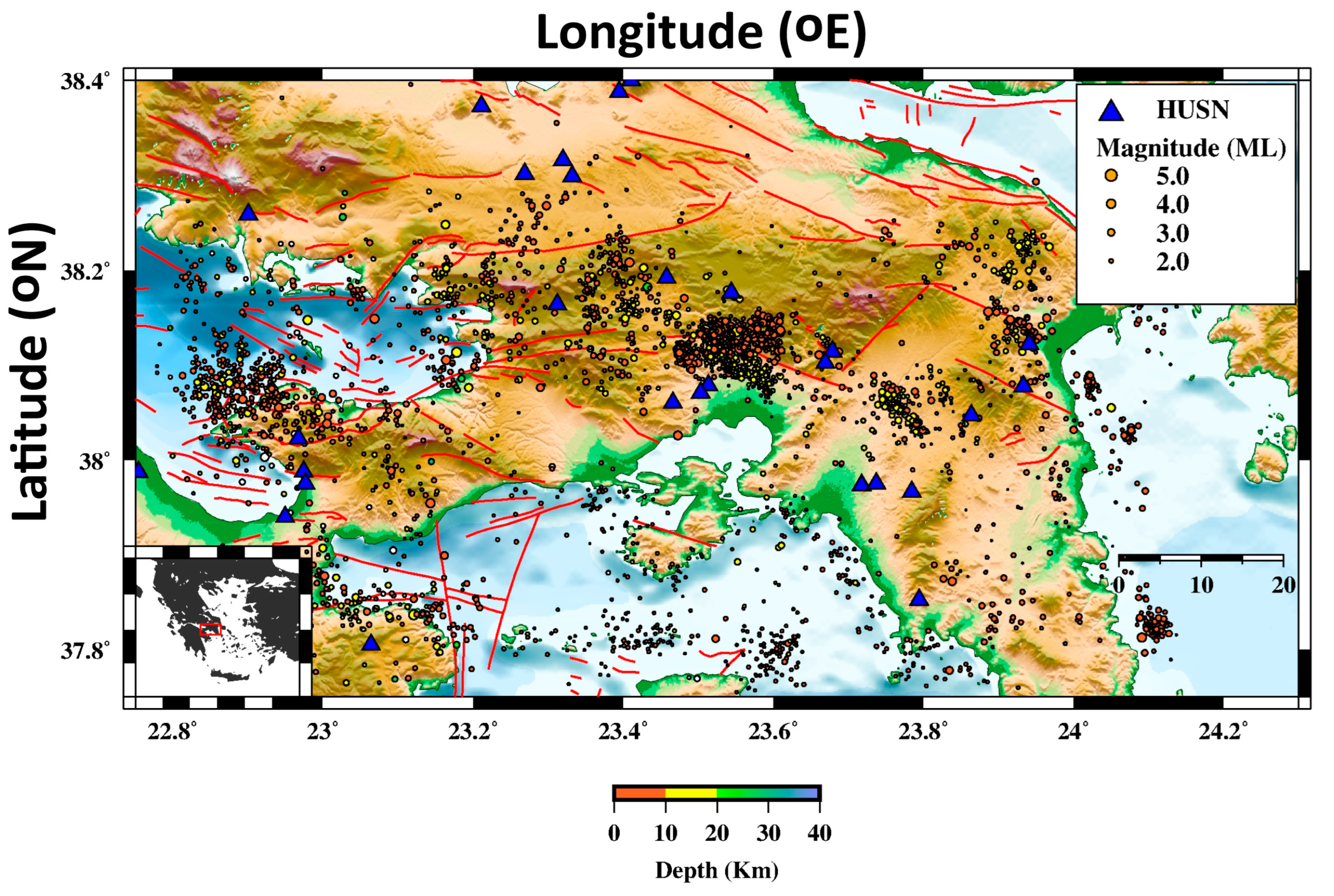
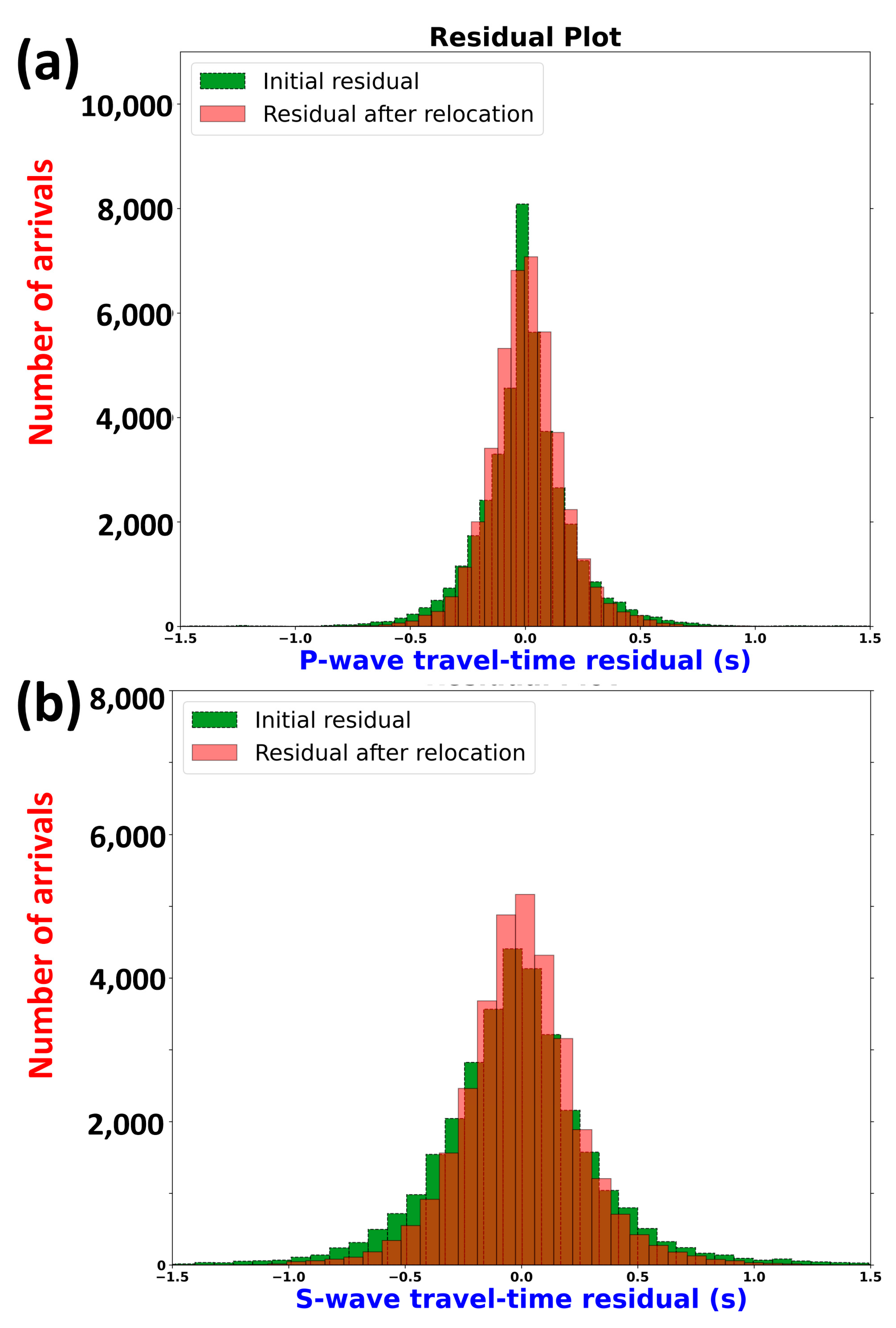
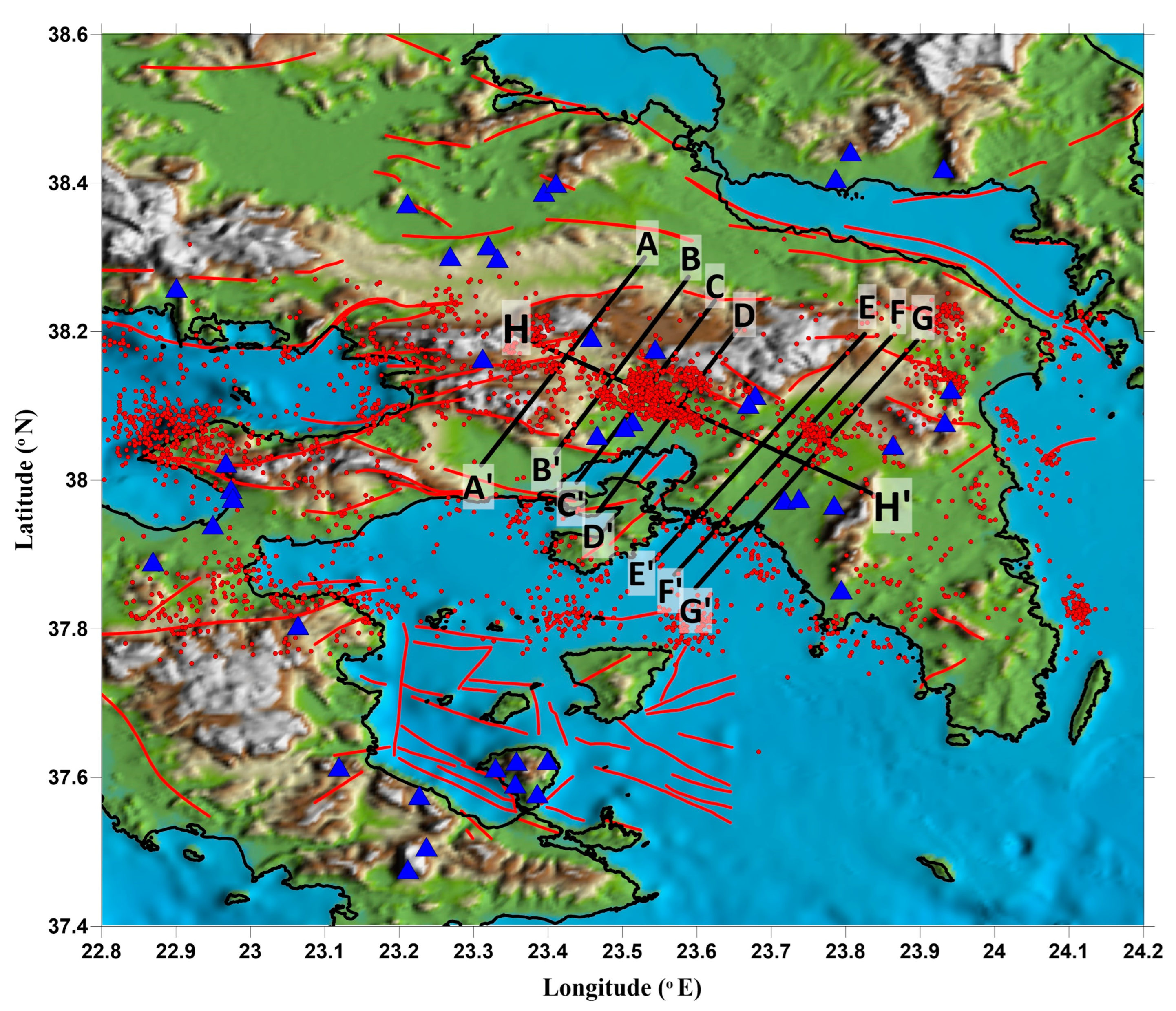
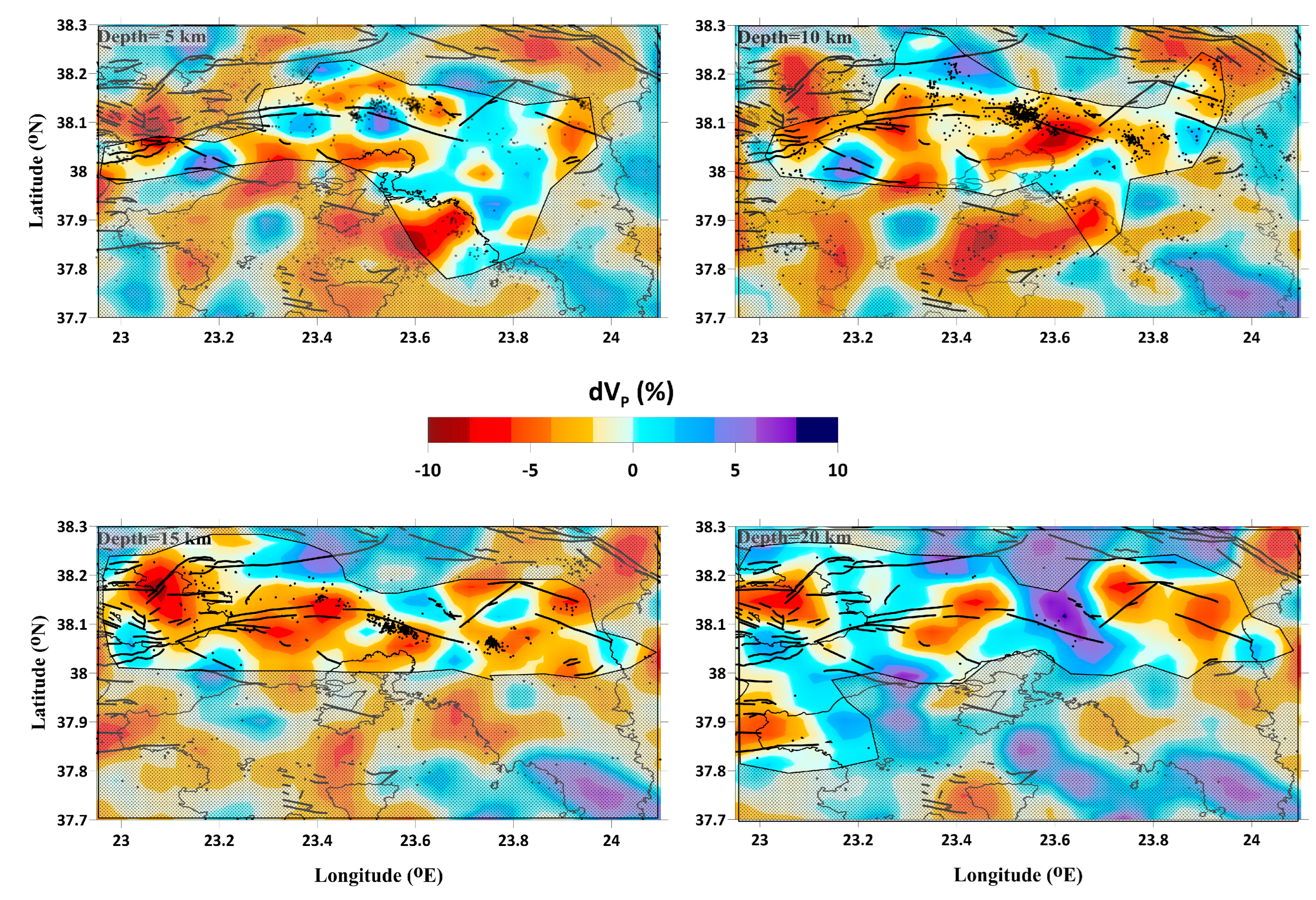
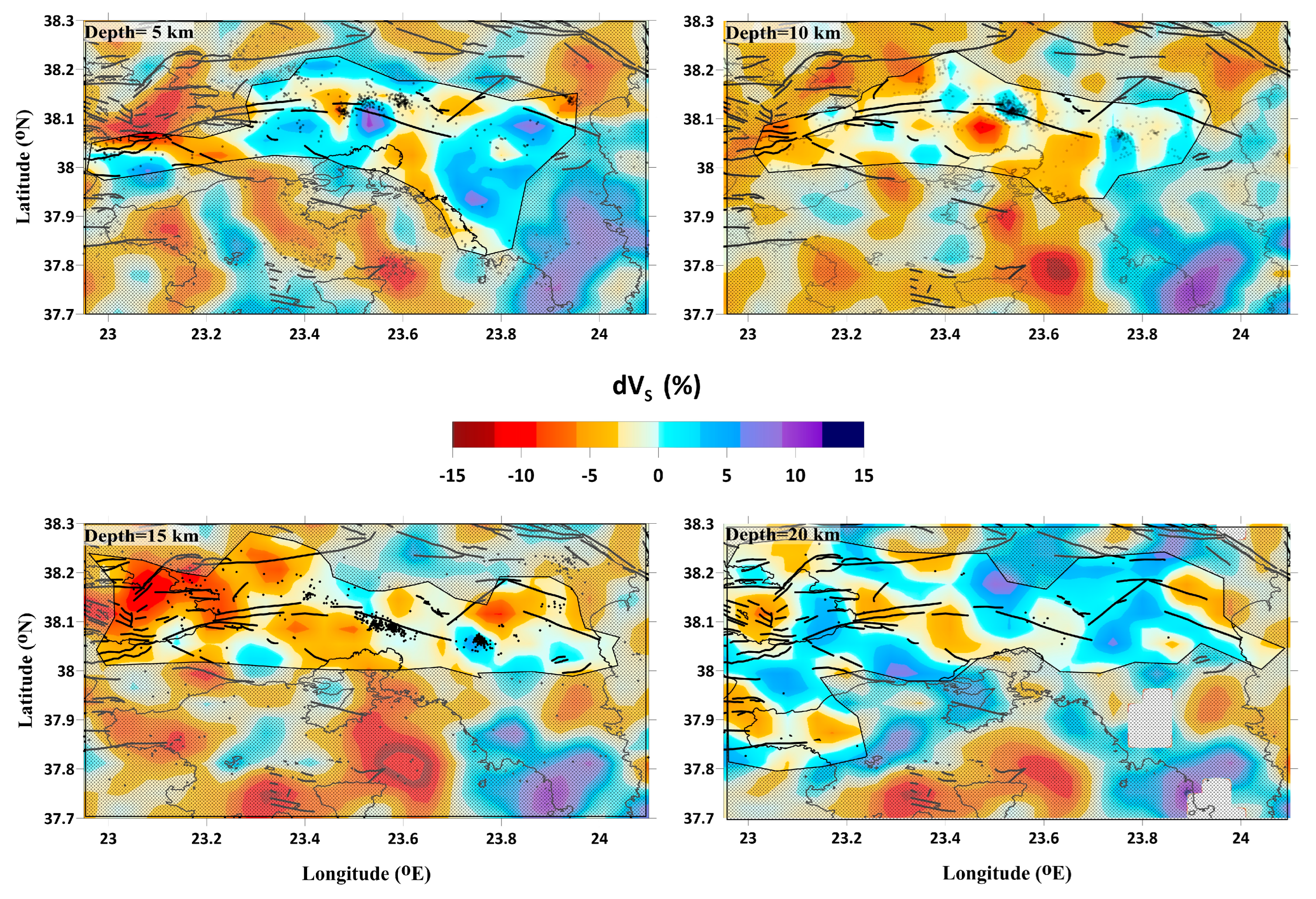
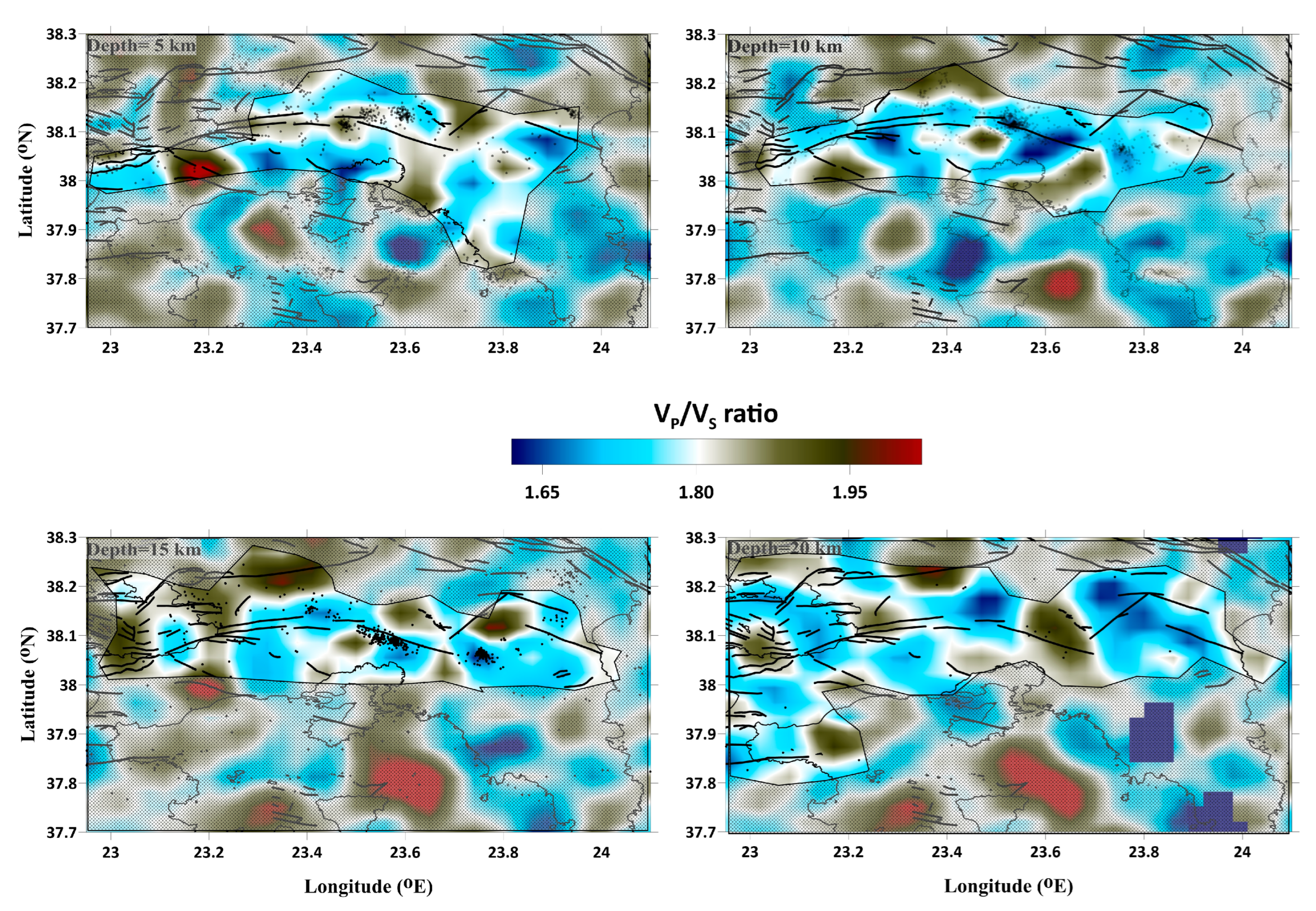

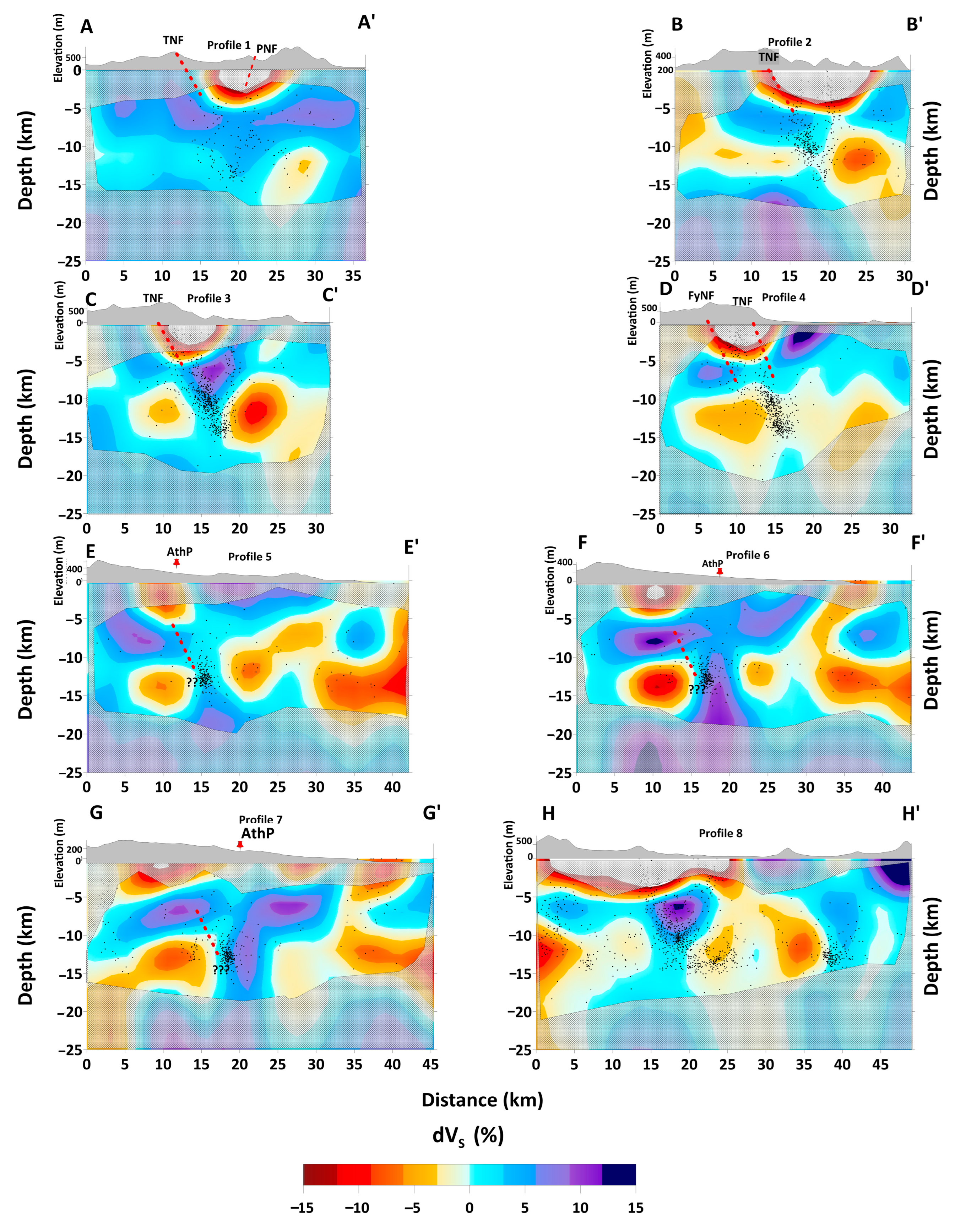
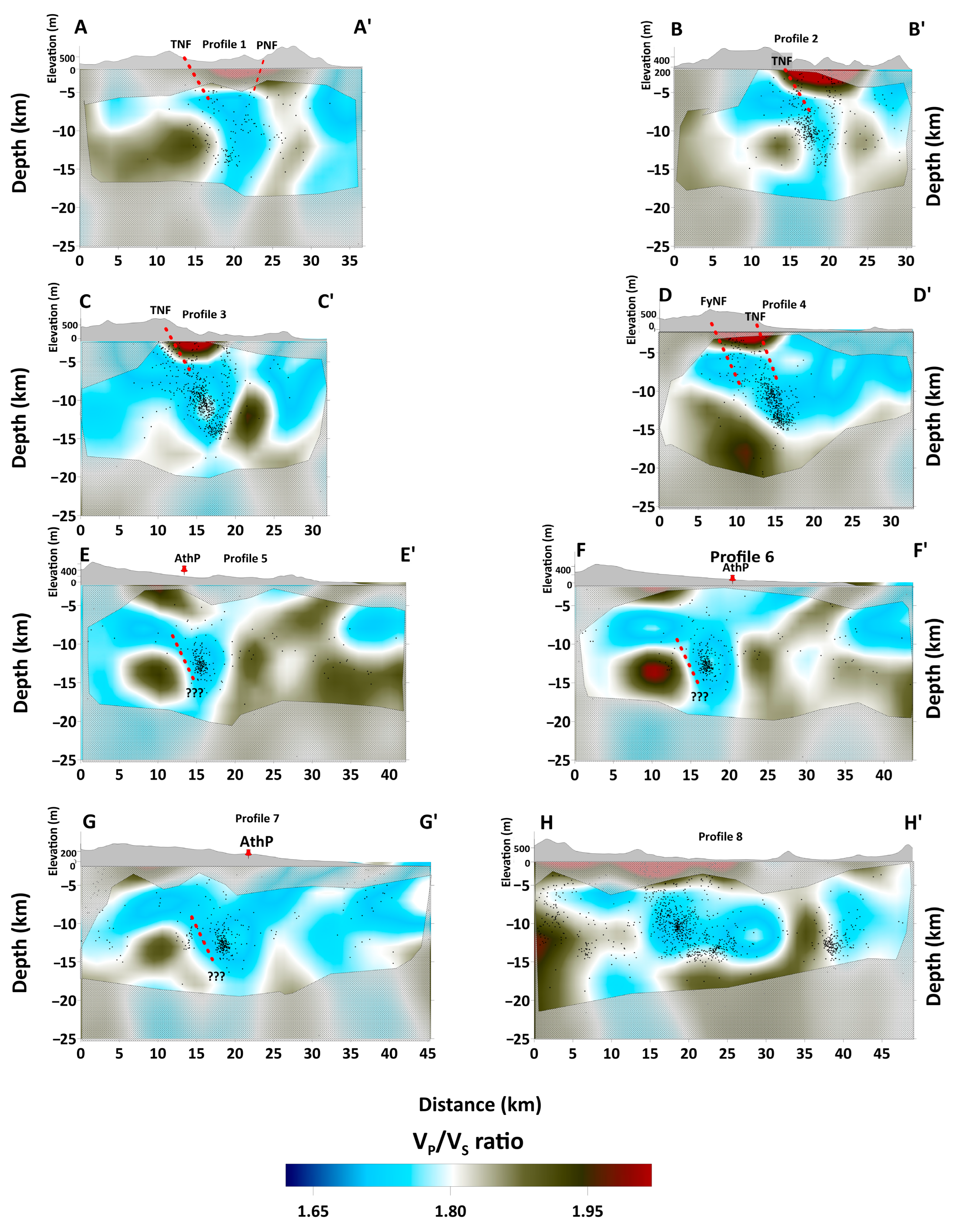
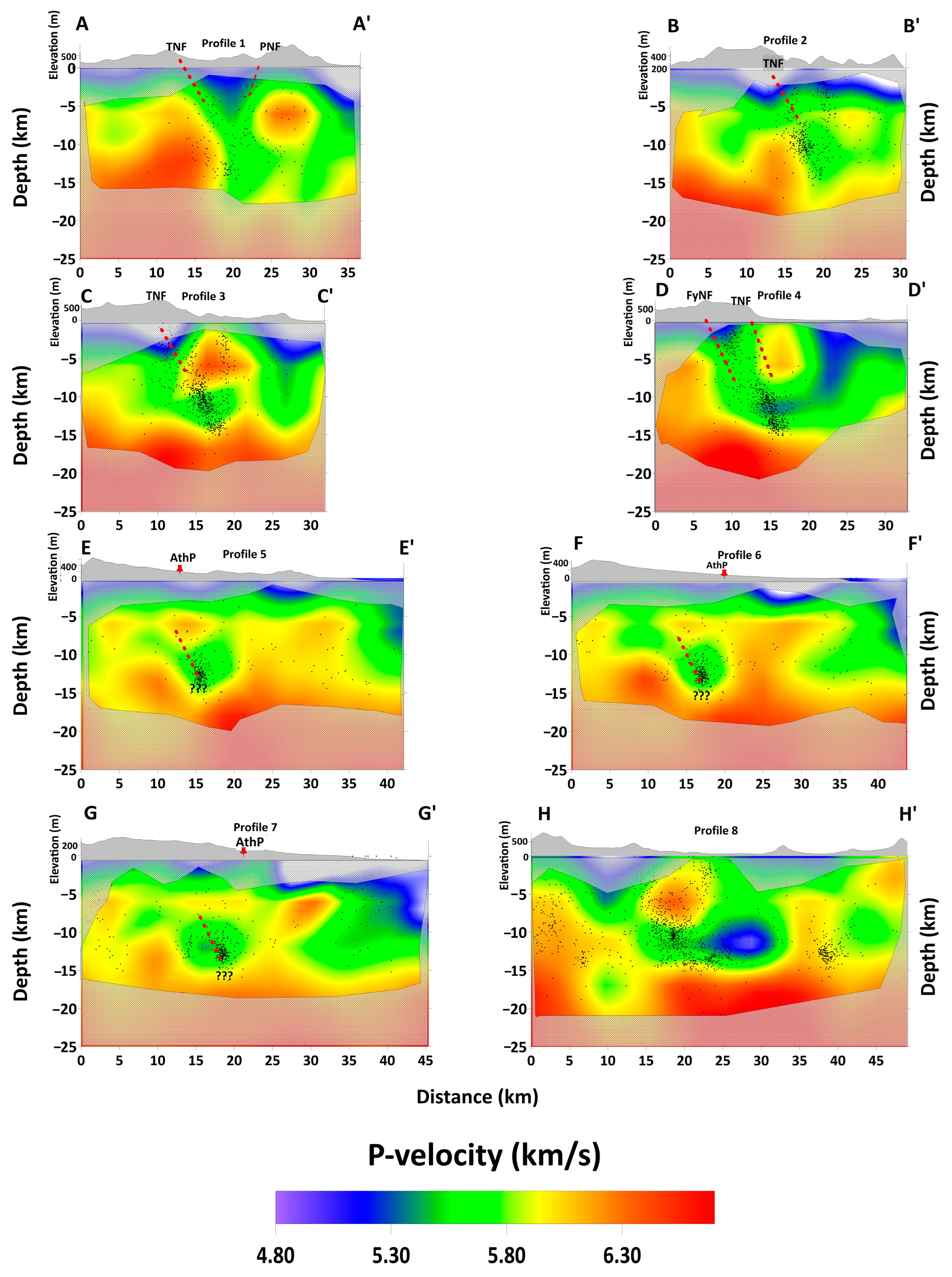
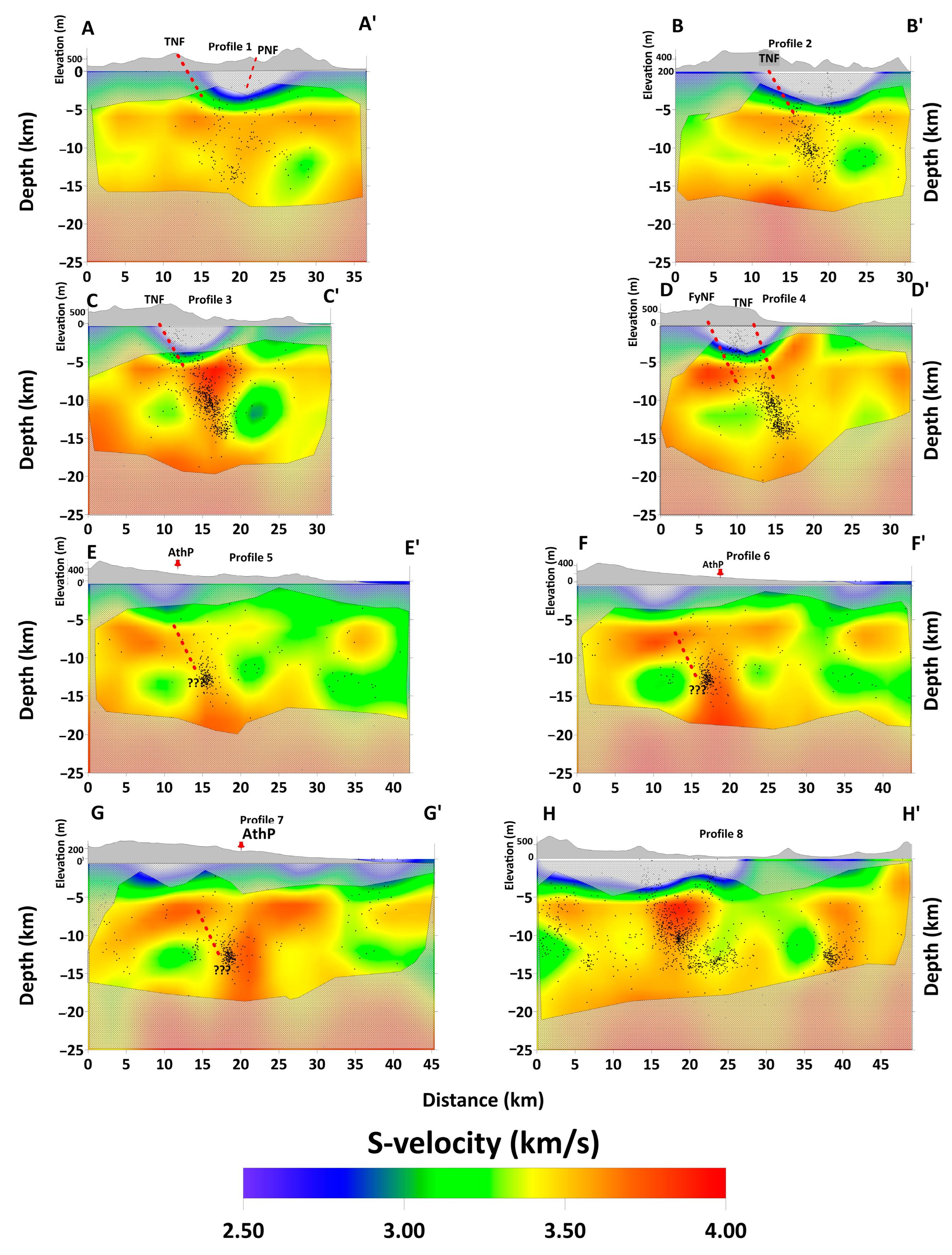

| Iteration | P-Residual (s) | P-Residual Reduction (%) | S-Residual (s) | S-Residual Reduction (%) |
|---|---|---|---|---|
| 1 | 0.227 | 0.00 | 0.573 | 0.00 |
| 2 | 0.184 | 18.79 | 0.349 | 18.10 |
| 3 | 0.175 | 22.89 | 0.302 | 20.56 |
| 4 | 0.171 | 24.75 | 0.286 | 22.66 |
| 5 | 0.169 | 25.54 | 0.278 | 23.95 |
Disclaimer/Publisher’s Note: The statements, opinions and data contained in all publications are solely those of the individual author(s) and contributor(s) and not of MDPI and/or the editor(s). MDPI and/or the editor(s) disclaim responsibility for any injury to people or property resulting from any ideas, methods, instructions or products referred to in the content. |
© 2024 by the authors. Licensee MDPI, Basel, Switzerland. This article is an open access article distributed under the terms and conditions of the Creative Commons Attribution (CC BY) license (https://creativecommons.org/licenses/by/4.0/).
Share and Cite
Karakonstantis, A.; Vallianatos, F. On the Footsteps of Active Faults from the Saronic Gulf to the Eastern Corinth Gulf: Application of Tomographic Inversion Using Recent Seismic Activity. Appl. Sci. 2024, 14, 6427. https://doi.org/10.3390/app14156427
Karakonstantis A, Vallianatos F. On the Footsteps of Active Faults from the Saronic Gulf to the Eastern Corinth Gulf: Application of Tomographic Inversion Using Recent Seismic Activity. Applied Sciences. 2024; 14(15):6427. https://doi.org/10.3390/app14156427
Chicago/Turabian StyleKarakonstantis, Andreas, and Filippos Vallianatos. 2024. "On the Footsteps of Active Faults from the Saronic Gulf to the Eastern Corinth Gulf: Application of Tomographic Inversion Using Recent Seismic Activity" Applied Sciences 14, no. 15: 6427. https://doi.org/10.3390/app14156427







